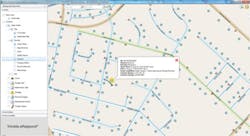By John Stenmark
Responding to incidents or problems in water service is a challenging combination of sticky engineering problems and complex logistics that must be resolved quickly. Because some incidents occur in public settings and affect hundreds or thousands of customers, they can pose a potential public relations crisis.
Experience shows that incident management is a crucial aspect of utility operations. Slow response, incomplete information and inaccurate estimates of outage duration can hamper repair efforts and erode public confidence. And while water and wastewater utilities can utilize sophisticated systems to supply clean water and collect and treat wastewater, the capabilities to manage incidents and outages often leave room for improvement.
Many utilities rely on manual processes to handle customer reports of leaks or service interruptions. The manual approach can hamper the effort to correlate problem reports to specific assets and locations. It may require dozens of phone conversations to fully identify and locate a problem. As a result, water and wastewater incidents can be exacerbated by slow response and subpar interaction with customers and other agencies.
Water Incident Management in Los Angeles
The Los Angeles Department of Water and Power (DWP) serves 3.8 million residents with water and electricity. The largest municipal water and power utility in the U.S., DWP provides service to roughly 650,000 meters. Faced with the challenges of aging infrastructure and limited budgets, it sought to improve management of incidents such as leaks, outages or quality issues in delivering water to its customers.
For years, DWP utilized three separate systems for water incident management: one system handled incidents such as outages, pressure variations or leaks; a second tracked issues related to water quality; and a third managed daily planned maintenance and repair activities being performed by DWP field crews. DWP wanted to streamline its water and wastewater operations, and to do so, it took a lesson from its sister utility: electricity.
For several years, electric utilities have used automated incident and outage management solutions. These systems combine asset management with geographic information system (GIS) technology and customer relationship management. The resulting interaction helps to improve response and cut costs. DWP wanted these capabilities in a commercial, off-the-shelf (COTS) system that would bring incident management for water service to the same level of performance provided to its electricity customers.
In 2013, DWP implemented the Trimble® eRespond® Incident Management solution to merge its three previously separate systems and improve overall incident management and customer relations. DWP selected eRespond in part because it was a proven solution for water and wastewater utilities of similar size. It also provided the ability to leverage DWP's existing Esri GIS. To improve customer relationship management, the eRespond solution could tie to DWP's new Oracle Customer Care and Billing (CC&B) software.
In addition to using customer calls for incident management, DWP can use Trimble eRespond to blend telemetry data from system pumps and facilities. This information often provides important input into the effort to locate and resolve a leak, pressure concern or water quality incident. Over time, improved asset management will help DWP achieve longer asset life and improve overall system operations.
Geographic Information for Incident Management
Water and wastewater utilities have miles of underground lines and assets spread over large areas. During incidents or outages, it's important to be able to send crews to the correct location. By connecting its asset database to Esri ArcGIS server, Trimble eRespond enables response managers to visualize the location and impact of incidents. The software also utilizes Esri applications to support asset management and planning activities. By augmenting schematic depictions of distribution or collection networks with maps and aerial imagery, the system provides information and flexibility for both field and office operations.
During an incident, crews can use the GIS to map the severity and extents of any spills to assist in notification, repairs and mitigation work. The spatial data also helps to fulfill requirements for reporting water or wastewater incidents to regulatory agencies. These capabilities soon paid off when a series of well-publicized incidents put DWP's eRespond system to the test.
Rapid Response
In July 2014, a 30-inch (76-cm) water main ruptured on the campus of the University of California at Los Angeles (UCLA). The burst pipe released millions of gallons of water into streets and nearby buildings. Using eRespond, DWP teams were able to identify the problem area and begin the process of shutting down the main. Calling on information from the GIS, DWP dispatched crews to operate water valves and isolate the pipe that normally carries 75,000 gallons (280,000 liters) of water per minute. Although crews reported that heavy traffic caused difficulty in driving to the various valves, water flowing to the massive pipe was fully stopped in roughly three hours -- a solid performance given the scope of the incident.
In September, a 36-inch (91-cm) water main ruptured beneath Sunset Boulevard. The flow of water was promptly shut off, and DWP managed the incident effectively, reporting that no residences were without water service during the incident. The work shut down the busy thoroughfare for two days while crews repaired the pipe and rebuilt the roadway. Also in September, a 12-inch (30-cm) pipe broke under a different section of Sunset Boulevard. The break occurred on a Sunday afternoon, and DWP crews had begun excavation and repairs by early evening. The street was returned to normal service before the next day's morning traffic.
Converting Data to Information
A key aspect of water incident management is its ability to utilize incoming calls and messages to produce actionable information. One incident may trigger a large number of reports from customers or municipal agencies. By collecting and analyzing incoming reports, the automated systems can quickly determine the likely location of trouble sources. Repair crews can be dispatched more efficiently and with the proper tools and parts. With automated systems, customers can receive faster responses to reports of water outages as well as estimates on repair times and callbacks when service is restored.
In addition to its geospatial capabilities, the eRespond solution facilitates best-in-class incident management through tight interaction with leading enterprise and asset management systems including SAP and the Oracle CC&B system. It is also SAFE certified (Solution Application Framework for Energy and Utilities) for use with IBM Maximo software. In its 2013 MarketScope report, the Gartner Group cited the eRespond system's unique abilities to coordinate with public emergency organizations and to scale to support small and large water and wastewater utilities.
The experience of the electric industry has set the stage for other utilities to benefit from automated systems for incident and operations management. By mimicking electric utilities' best practices in technology for asset and incident management, DWP has demonstrated that it can gain efficiency, reduce leakage and non-revenue water, cut costs, and improve customer service.
About the Author: John Stenmark is a writer and consultant working in the geospatial, AEC and associated industries. He has more than 25 years of experience in applying advanced technologies to surveying and related disciplines. He may be contacted at [email protected].
More WaterWorld Current Issue Articles
More WaterWorld Archives Issue Articles






